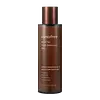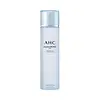What's inside
What's inside
 Key Ingredients
Key Ingredients

 Benefits
Benefits

 Concerns
Concerns

 Ingredients Side-by-side
Ingredients Side-by-side

Water
Skin ConditioningButylene Glycol
HumectantPropanediol
SolventNiacinamide
Smoothing1,2-Hexanediol
Skin ConditioningDimethicone
EmollientPPG-13-Decyltetradeceth-24
EmulsifyingAlcohol Denat.
AntimicrobialAmmonium Acryloyldimethyltaurate/Vp Copolymer
Glyceryl Caprylate
EmollientAcrylates/C10-30 Alkyl Acrylate Crosspolymer
Emulsion StabilisingHydrogenated Lecithin
EmulsifyingEthylhexylglycerin
Skin ConditioningAdenosine
Skin ConditioningTromethamine
BufferingParfum
MaskingDisodium EDTA
Panthenol
Skin ConditioningHyaluronic Acid
HumectantCamellia Sinensis Leaf Extract
AntimicrobialLimonene
PerfumingDextrin
AbsorbentTheobroma Cacao Shell Extract
Skin ConditioningSodium Methyl Stearoyl Taurate
CleansingLinalool
PerfumingTocopherol
AntioxidantWater, Butylene Glycol, Propanediol, Niacinamide, 1,2-Hexanediol, Dimethicone, PPG-13-Decyltetradeceth-24, Alcohol Denat., Ammonium Acryloyldimethyltaurate/Vp Copolymer, Glyceryl Caprylate, Acrylates/C10-30 Alkyl Acrylate Crosspolymer, Hydrogenated Lecithin, Ethylhexylglycerin, Adenosine, Tromethamine, Parfum, Disodium EDTA, Panthenol, Hyaluronic Acid, Camellia Sinensis Leaf Extract, Limonene, Dextrin, Theobroma Cacao Shell Extract, Sodium Methyl Stearoyl Taurate, Linalool, Tocopherol
Water
Skin ConditioningDipropylene Glycol
HumectantGlycerin
HumectantBetaine
Humectant1,2-Hexanediol
Skin ConditioningNiacinamide
SmoothingPropanediol
SolventAlcohol Denat.
AntimicrobialGlycereth-26
HumectantButylene Glycol
HumectantEnteromorpha Compressa Extract
Skin ProtectingCodium Tomentosum Extract
Skin ProtectingUndaria Pinnatifida Extract
Skin ConditioningGlycereth-25 PCA Isostearate
EmulsifyingArtemisia Princeps Leaf Extract
Skin ConditioningEthylhexylglycerin
Skin ConditioningMaris Aqua
HumectantParfum
MaskingAdenosine
Skin ConditioningAmmonium Acryloyldimethyltaurate/Vp Copolymer
Disodium EDTA
Biosaccharide Gum-1
HumectantSodium Hyaluronate
HumectantRosa Damascena Flower Water
MaskingBetula Alba Juice
AstringentCaprylic/Capric Triglyceride
MaskingHydrogenated Lecithin
EmulsifyingButyrospermum Parkii Butter
Skin ConditioningCamellia Sinensis Leaf Water
MaskingCeramide NP
Skin ConditioningCaprylyl Glycol
EmollientAnthemis Nobilis Flower Water
MaskingDaucus Carota Sativa Root Water
MaskingChamaecyparis Obtusa Water
MaskingThuja Orientalis Extract
AntimicrobialCitrus Unshiu Peel Extract
MaskingVitis Vinifera Fruit Water
Skin ConditioningOryza Sativa Bran Water
MaskingPrunus Mume Fruit Water
HumectantCeramide Ns
Skin ConditioningCeramide As
Skin ConditioningCeramide AP
Skin ConditioningCholesterol
EmollientEucalyptus Globulus Leaf Extract
PerfumingPhytosphingosine
Skin ConditioningAsiatic Acid
Skin ConditioningMadecassic Acid
Skin ConditioningAsiaticoside
AntioxidantCeramide EOP
Skin ConditioningWater, Dipropylene Glycol, Glycerin, Betaine, 1,2-Hexanediol, Niacinamide, Propanediol, Alcohol Denat., Glycereth-26, Butylene Glycol, Enteromorpha Compressa Extract, Codium Tomentosum Extract, Undaria Pinnatifida Extract, Glycereth-25 PCA Isostearate, Artemisia Princeps Leaf Extract, Ethylhexylglycerin, Maris Aqua, Parfum, Adenosine, Ammonium Acryloyldimethyltaurate/Vp Copolymer, Disodium EDTA, Biosaccharide Gum-1, Sodium Hyaluronate, Rosa Damascena Flower Water, Betula Alba Juice, Caprylic/Capric Triglyceride, Hydrogenated Lecithin, Butyrospermum Parkii Butter, Camellia Sinensis Leaf Water, Ceramide NP, Caprylyl Glycol, Anthemis Nobilis Flower Water, Daucus Carota Sativa Root Water, Chamaecyparis Obtusa Water, Thuja Orientalis Extract, Citrus Unshiu Peel Extract, Vitis Vinifera Fruit Water, Oryza Sativa Bran Water, Prunus Mume Fruit Water, Ceramide Ns, Ceramide As, Ceramide AP, Cholesterol, Eucalyptus Globulus Leaf Extract, Phytosphingosine, Asiatic Acid, Madecassic Acid, Asiaticoside, Ceramide EOP
 Reviews
Reviews

Ingredients Explained
These ingredients are found in both products.
Ingredients higher up in an ingredient list are typically present in a larger amount.
1,2-Hexanediol is a synthetic liquid and another multi-functional powerhouse.
It is a:
- Humectant, drawing moisture into the skin
- Emollient, helping to soften skin
- Solvent, dispersing and stabilizing formulas
- Preservative booster, enhancing the antimicrobial activity of other preservatives
Adenosine is in every living organism. It is one of four components in nucleic acids that helps store our DNA.
Adenosine has many benefits when used. These benefits include hydrating the skin, smoothing skin, and reducing wrinkles. Once applied, adenosine increases collagen production. It also helps with improving firmness and tissue repair.
Studies have found adenosine may also help with wound healing.
In skincare products, Adenosine is usually derived from yeast.
Learn more about AdenosineAlcohol Denat. is an alcohol with a denaturant property. It is created by mixing ethanol with other additives.
This ingredient gets a bad rep because it is irritating and drying - mostly due to its astringent property. Astringents draw out natural oils in tissue, constricting pores and leaving your skin dried out.
However, alcohol denat. is not all that bad.
Due to its low molecular weight, alcohol denat. tends to evaporate quickly. One study on pig skin found half of applied alcohol evaporated in 10 seconds and less than 3% stayed on skin.
This also helps other ingredients become better absorbed upon application.
Studies are conflicted about whether this ingredient causes skin dehydration. One study from 2005 found adding emollients to propanol-based sanitizer decreased skin dryness and irritation. Another study found irritation only occurs if your skin is already damaged.
Small amounts of alcohol are generally tolerated by oily skin or people who live in humid environments.
The rule of thumb is if this alcohol is near the end of an ingredients list, it will probably not affect your skin much.
Also...
This ingredient has antimicrobial and solvent properties.
The antimicrobial property helps preserve products and increase their shelf life. As a solvent, it helps dissolve other ingredients.
Other types of astringent alcohols include:
Learn more about Alcohol Denat.Ammonium Acryloyldimethyltaurate/Vp Copolymer (let's call it AAVC for short) is a synthetically created polymer. It's used as a film-forming agent and used to thicken the consistency of products.
AAVC is able to increase the consistency and viscosity of products due to its large molecule size. It also prevents ingredients from separating.
Butylene Glycol (or BG) is used within cosmetic products for a few different reasons:
Overall, Butylene Glycol is a safe and well-rounded ingredient that works well with other ingredients.
Though this ingredient works well with most skin types, some people with sensitive skin may experience a reaction such as allergic rashes, closed comedones, or itchiness.
Learn more about Butylene GlycolDisodium EDTA plays a role in making products more stable by aiding other preservatives.
It is a chelating agent, meaning it neutralizes metal ions that may be found in a product.
Disodium EDTA is a salt of edetic acid and is found to be safe in cosmetic ingredients.
Learn more about Disodium EDTAEthylhexylglycerin (we can't pronounce this either) is commonly used as a preservative and skin softener. It is derived from glyceryl.
You might see Ethylhexylglycerin often paired with other preservatives such as phenoxyethanol. Ethylhexylglycerin has been found to increase the effectiveness of these other preservatives.
Hydrogenated Lecithin is created from the hydrogenation of lecithin (a group of phospholipids). Hydrogenation is a chemical reaction between hydrogen and another element.
This ingredient is an emollient and emulsifier. As an emollient, it helps soften skin by trapping moisture within. As an emulsifier, it prevents oil and water ingredients from separating.
Niacinamide is a multitasking form of vitamin B3 that strengthens the skin barrier, reduces pores and dark spots, regulates oil, and improves signs of aging.
And the best part? It's gentle and well-tolerated by most skin types, including sensitive and reactive skin.
You might have heard of "niacin flush", or the reddening of skin that causes itchiness. Niacinamide has not been found to cause this.
In very rare cases, some individuals may not be able to tolerate niacinamide at all or experience an allergic reaction to it.
If you are experiencing flaking, irritation, and dryness with this ingredient, be sure to double check all your products as this ingredient can be found in all categories of skincare.
When incorporating niacinamide into your routine, look out for concentration amounts. Typically, 5% niacinamide provides benefits such as fading dark spots. However, if you have sensitive skin, it is better to begin with a smaller concentration.
When you apply niacinamide to your skin, your body converts it into nicotinamide adenine dinucleotide (NAD). NAD is an essential coenzyme that is already found in your cells as "fuel" and powers countless biological processes.
In your skin, NAD helps repair cell damage, produce new healthy cells, support collagen production, strengthen the skin barrier, and fight environmental stressors (like UV and pollution).
Our natural NAD levels start to decline with age, leading to slower skin repair, visible aging, and a weaker skin barrier. By providing your skin niacinamide, you're recharging your skin's NAD levels. This leads to stronger, healthier, and younger looking skin.
Another name for vitamin B3 is nicotinamide. This vitamin is water-soluble and our bodies don't store it. We obtain Vitamin B3 from either food or skincare. Meat, fish, wheat, yeast, and leafy greens contain vitamin B3.
The type of niacinamide used in skincare is synthetically created.
Learn more about NiacinamideParfum is a catch-all term for an ingredient or more that is used to give a scent to products.
Also called "fragrance", this ingredient can be a blend of hundreds of chemicals or plant oils. This means every product with "fragrance" or "parfum" in the ingredients list is a different mixture.
For instance, Habanolide is a proprietary trade name for a specific aroma chemical. When used as a fragrance ingredient in cosmetics, most aroma chemicals fall under the broad labeling category of “FRAGRANCE” or “PARFUM” according to EU and US regulations.
The term 'parfum' or 'fragrance' is not regulated in many countries. In many cases, it is up to the brand to define this term.
For instance, many brands choose to label themselves as "fragrance-free" because they are not using synthetic fragrances. However, their products may still contain ingredients such as essential oils that are considered a fragrance by INCI standards.
One example is Calendula flower extract. Calendula is an essential oil that still imparts a scent or 'fragrance'.
Depending on the blend, the ingredients in the mixture can cause allergies and sensitivities on the skin. Some ingredients that are known EU allergens include linalool and citronellol.
Parfum can also be used to mask or cover an unpleasant scent.
The bottom line is: not all fragrances/parfum/ingredients are created equally. If you are worried about fragrances, we recommend taking a closer look at an ingredient. And of course, we always recommend speaking with a professional.
Learn more about ParfumPropanediol is an all-star ingredient. It softens, hydrates, and smooths the skin.
It’s often used to:
Propanediol is not likely to cause sensitivity and considered safe to use. It is derived from corn or petroleum with a clear color and no scent.
Learn more about PropanediolWater. It's the most common cosmetic ingredient of all. You'll usually see it at the top of ingredient lists, meaning that it makes up the largest part of the product.
So why is it so popular? Water most often acts as a solvent - this means that it helps dissolve other ingredients into the formulation.
You'll also recognize water as that liquid we all need to stay alive. If you see this, drink a glass of water. Stay hydrated!
Learn more about Water